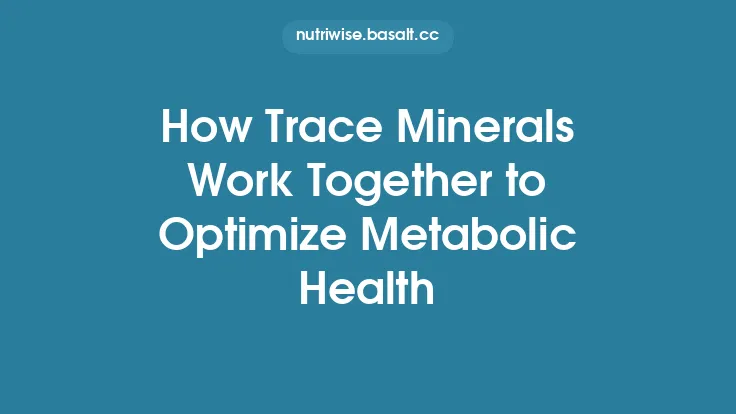The human body relies on a finely tuned network of trace minerals—elements required in minute quantities but essential for virtually every biochemical process. While each mineral possesses distinct physiological roles, their absorption does not occur in isolation. The intestinal lumen, transport proteins, cellular chaperones, and systemic regulatory circuits all operate as an integrated system, allowing multiple trace elements to influence one another’s bioavailability and ultimate functional impact. Understanding how these minerals interact during the absorption phase is crucial for developing holistic approaches to micronutrient adequacy, preventing hidden deficiencies, and optimizing overall health.
The Physiological Landscape of Trace Mineral Absorption
Absorption of trace minerals begins primarily in the duodenum and proximal jejunum, where the acidic environment (pH ≈ 1–3) solubilizes dietary complexes and liberates free ions. From there, a series of specialized transporters mediate entry into enterocytes:
| Transporter | Primary Substrates | Mechanism |
|---|---|---|
| Divalent Metal Transporter‑1 (DMT1) | Fe²⁺, Mn²⁺, Zn²⁺, Co²⁺, Ni²⁺ | Proton‑coupled symport; low‑affinity, high‑capacity |
| ZIP (Zrt‑ and Irt‑like Protein) family | Zn²⁺, Fe²⁺, Cu⁺ (ZIP8/14) | Facilitates influx of divalent cations; regulated by intracellular metal status |
| ZnT (Zinc Transporter) family | Zn²⁺, Fe²⁺ (ZnT1) | Efflux from cytosol to extracellular space or into vesicles |
| Copper Transporter 1 (CTR1) | Cu⁺ | High‑affinity, trimeric channel |
| SLC30A10 | Mn²⁺ | Efflux from enterocytes into the portal circulation |
| Manganese‑Specific Transporter (SLC39A14) | Mn²⁺ | Uptake into enterocytes |
These transporters are not exclusive to a single element; many exhibit overlapping substrate specificity. Consequently, the presence of one trace mineral can modulate the kinetic parameters (Km, Vmax) of another, either enhancing or inhibiting its uptake. The net effect depends on concentration gradients, transporter expression levels, and the presence of competitive ligands.
Interdependence of Transport Mechanisms
Competitive Inhibition and Cooperative Uptake
When two minerals share a transporter, they compete for binding sites. For example, high dietary iron can suppress manganese absorption via DMT1 competition, while excess zinc may impede copper uptake through shared ZIP transporters. Conversely, certain minerals can facilitate each other’s transport. The copper chaperone ATOX1, for instance, can stabilize the conformation of CTR1, indirectly supporting copper influx when intracellular copper pools are low.
Regulation of Transporter Expression
The body dynamically adjusts transporter abundance in response to systemic mineral status. Hepcidin, a liver‑derived peptide, down‑regulates DMT1 and ferroportin in enterocytes during iron overload, indirectly affecting manganese and zinc absorption due to shared pathways. Similarly, metallothionein (MT) expression is up‑regulated by zinc and copper, sequestering excess metals and modulating the availability of transporters for other trace elements.
Role of Metalloproteins and Chaperones in Coordinated Distribution
Once inside the enterocyte, trace minerals rarely remain free; they are rapidly bound to intracellular ligands that dictate their intracellular trafficking and eventual release into the bloodstream.
- Metallothionein (MT): A cysteine‑rich protein with high affinity for Zn²⁺, Cu⁺, Cd²⁺, and Hg²⁺. MT buffers cytosolic concentrations, preventing toxicity while serving as a reservoir that can be mobilized during periods of deficiency.
- Ceruloplasmin: The primary copper‑carrying protein in plasma; it also oxidizes Fe²⁺ to Fe³⁺, facilitating iron loading onto transferrin. This dual function exemplifies how a single protein can bridge the metabolism of two trace minerals.
- Ferritin: Stores iron but can also accommodate manganese and zinc within its mineral core, providing a shared depot that buffers fluctuations in dietary intake.
- Copper Chaperones (e.g., ATOX1, CCS): Direct copper to specific enzymes (e.g., cytochrome c oxidase, superoxide dismutase) while preventing free copper from catalyzing harmful redox reactions. Their activity can be modulated by zinc status, as zinc‑induced MT expression can sequester copper, altering chaperone availability.
These proteins act as “traffic controllers,” ensuring that each mineral reaches its target organ or enzyme in the correct stoichiometric ratio, thereby preserving functional synergy across physiological systems.
Influence of Macro Nutrients and Phytochemicals on Multi‑Mineral Bioavailability
Organic Acids and Amino Acid Complexes
Citric, malic, and lactic acids form soluble complexes with many trace minerals, enhancing their solubility at intestinal pH and reducing precipitation with dietary antagonists (e.g., phytates). Amino acids such as histidine and cysteine can chelate metals, forming peptide‑metal complexes that are absorbed via peptide transporters (PEPT1), bypassing competition at DMT1.
Vitamin‑Mediated Modulation
- Vitamin C (ascorbic acid): Reduces Fe³⁺ to Fe²⁺, increasing DMT1 affinity, and also stabilizes Cu⁺, facilitating CTR1 transport. High vitamin C intake can therefore simultaneously boost iron and copper absorption, potentially influencing each other’s homeostasis.
- Vitamin B₆ (pyridoxal‑5′‑phosphate): Serves as a co‑factor for enzymes that metabolize zinc and manganese, indirectly affecting their intracellular utilization.
Antagonistic Phytochemicals
Phytates (myo‑inositol hexakisphosphate) and oxalates bind divalent cations with high affinity, forming insoluble complexes that resist absorption. Their impact is not uniform; iron and zinc are more strongly chelated than copper, leading to differential reductions in bioavailability when these compounds are present in the diet.
The Gut Microbiome as a Mediator of Trace Mineral Integration
The intestinal microbiota exerts profound influence on trace mineral dynamics through several mechanisms:
- Siderophore Production: Certain bacteria synthesize high‑affinity iron‑chelating molecules (siderophores) that can liberate iron from otherwise inaccessible complexes, increasing its availability for host absorption. Some siderophores also bind manganese, indirectly affecting its uptake.
- Microbial Metabolism of Organic Ligands: Fermentation of dietary fibers yields short‑chain fatty acids (SCFAs) that lower luminal pH, enhancing solubility of many trace minerals.
- Modulation of Host Transporter Expression: Microbial metabolites such as butyrate can up‑regulate DMT1 and ZIP transporters via activation of transcription factors (e.g., HIF‑1α), thereby influencing the concurrent absorption of multiple minerals.
- Competitive Sequestration: Certain commensals can accumulate trace metals for their own metabolic needs, effectively acting as a sink that reduces host bioavailability. This is particularly relevant for copper and zinc, where bacterial metallothionein analogs can sequester excess ions.
Understanding these bidirectional interactions is essential for appreciating why two individuals consuming identical diets may exhibit divergent trace mineral status.
Homeostatic Regulation and Cross‑Talk Among Trace Elements
Systemic mineral balance is maintained through hormonal and cellular feedback loops that often involve more than one trace element:
- Hepcidin‑Iron Axis: While primarily an iron regulator, hepcidin’s suppression of ferroportin also limits manganese export from enterocytes, illustrating cross‑talk between iron and manganese pathways.
- Copper‑Zinc Antagonism via MT: Elevated zinc induces MT, which preferentially binds copper, reducing serum copper concentrations. This antagonism is a classic example of how the homeostatic response to one mineral can inadvertently affect another.
- Manganese‑Calcium Interaction: High calcium intake can down‑regulate SLC30A10, decreasing manganese efflux and potentially leading to manganese accumulation in the gut epithelium.
These interdependencies underscore the necessity of viewing trace mineral status as a network rather than isolated variables.
Implications for Clinical Assessment and Personalized Nutrition
Given the intertwined nature of trace mineral absorption, conventional single‑nutrient assays may provide an incomplete picture. A more nuanced approach includes:
- Comprehensive Panel Testing: Simultaneous measurement of serum ferritin, transferrin saturation, zinc, copper, manganese, and ceruloplasmin offers insight into potential competitive interactions.
- Biomarkers of Transporter Activity: Emerging assays for urinary excretion of DMT1‑derived peptides or fecal expression of ZIP transporters can reflect functional absorption capacity.
- Genetic Screening: Polymorphisms in genes encoding DMT1, MT, or CTR1 influence individual susceptibility to deficiencies or toxicities, informing personalized supplementation strategies.
- Microbiome Profiling: Metagenomic analysis can identify bacterial taxa associated with enhanced siderophore production or SCFA generation, suggesting probiotic or prebiotic interventions that indirectly modulate mineral absorption.
Clinicians should interpret laboratory results within the context of these interrelationships, recognizing that a “normal” value for one mineral may mask a subclinical deficiency of another.
Future Directions in Research on Integrated Trace Mineral Absorption
The field is moving toward systems‑level investigations that capture the dynamic interplay of multiple trace elements:
- Multi‑omics Integration: Combining transcriptomics (transporter expression), proteomics (metalloprotein abundance), and metabolomics (organic acid profiles) can map the holistic absorption landscape.
- Advanced Imaging: Synchrotron X‑ray fluorescence microscopy enables spatial visualization of trace mineral distribution within intestinal tissue, revealing micro‑regional competition or co‑localization.
- Nanocarrier Delivery Systems: Engineered liposomal or polymeric nanoparticles can co‑encapsulate complementary trace minerals, protecting them from antagonistic dietary factors and delivering them via receptor‑mediated endocytosis.
- Artificial Intelligence Modeling: Machine‑learning algorithms trained on large datasets of dietary intake, genetic variants, and biomarker profiles can predict individual absorption efficiencies and guide precision nutrition recommendations.
These innovations promise to refine our understanding of how multiple trace minerals are simultaneously handled by the body, paving the way for interventions that respect the inherent synergy of micronutrient nutrition.
By appreciating the shared transport routes, intracellular chaperones, regulatory hormones, and microbial partners that govern trace mineral absorption, we can move beyond a reductionist view of nutrition. Integrating multiple trace elements into a cohesive, systems‑based framework enables clinicians, researchers, and nutrition professionals to address subtle imbalances, optimize bioavailability, and ultimately support the complex biochemical tapestry that sustains human health.





